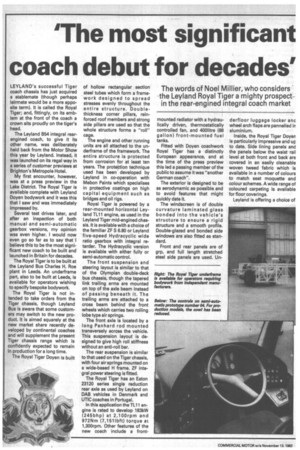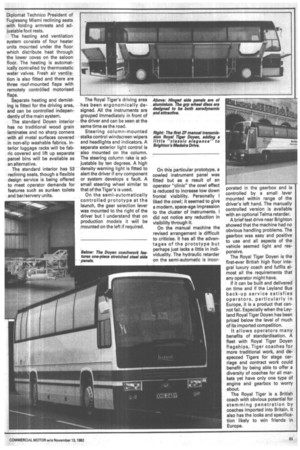'The most significant coach debut for decades'
Page 36

Page 37

If you've noticed an error in this article please click here to report it so we can fix it.
The words of Noel Millier, who considers the Leyland Royal Tiger a mighty prospectin the rear-engined integral coach market
LEYLAND's successful Tiger coach chassis has just acquired a stablemate (though perhaps lairmate would be a more apposite term). It is called the Royal Tiger; and, fittingly, on its emblem at the front of the coach a crown sits proudly on the tiger's head.
The Leyland B54 integral rearengined coach, to give it its other name, was deliberately held back from the Motor Show this year by Leyland. Instead, it was launched on its regal way in a series of customer previews at Brighton's Metropole Hotel.
My first encounter, however, was at a press preview in the Lake District. The Royal Tiger is available complete with Leyland Doyen bodywork and it was this that I saw and was immediately impressed by.
Several test drives later, and after an inspection of both manual and semi-automatic gearbox versions, my opinion was even higher. I would now even go so far as to say that I believe this to be the most significant new coach to be built and launched in Britain for decades.
The Royal Tiger is to be built at the Leyland Bus Charles H. Roe plant in Leeds. An underframe part, also to be built at Leeds, is available for operators wishing to specify bespoke bodywork.
The Royal Tiger is not intended to take orders from the Tiger chassis, though Leyland Bus is aware that some customers may switch to the new product. It is aimed squarely at the new market share recently developed by continental coaches and will supplement the present Tiger chassis range which is confidently expected to remain in production for a long time.
The Royal Tiger Doyen is built of hollow rectangular section steel tubes which form a framework designed to spread stresses evenly throughout the entire structure. Doublethickness corner pillars, reinforced roof members and strong side pillars are used so that the whole structure forms a "roll" cage.
The engine and other running units are all attached to the underframe of the framework. The entire structure is protected from corrosion for at least ten years. The protection technique used has been developed by Leyland in co-operation with Mebon Paints which specialises in protective coatings on high capital equipment such as bridges and oil rigs.
Royal Tiger is powered by a rear-mounted horizontal Leyland TL11 engine, as used in the Leyland Tiger mid-engined chassis. It is available with a choice of the familiar ZF S 6.80 or Leyland five-speed Hydracyclic wide ratio gearbox with integral retarder. The Hydracyclic version is available with either fully or semi-automatic control.
The front suspension and steering layout is similar to that of the Olympian double-deck bus chassis, though the tapered link trailing arms are mounted on top of the axle beam instead of passing beneath it. The trailing arms are attached to a cross beam behind the front wheels which carries two rolling lobe type air springs.
The front axle is located by a long Panhard rod mounted transversely across the vehicle. This suspension layout is designed to give high roll stiffness without an anti-roll bar.
The rear suspension is similar to that used on the Tiger chassis, with four air springs mounted on a wide-based H frame. ZF integral power steering is fitted.
The Royal Tiger has an Eaton 23120 series single reduction rear axle as used by Leyland on DAB vehicles in Denmark and UTIC coaches in Portugal.
In this application the TL11 engine is rated to develop 1831AN (245bhp) at 2,1 0Orpm and 972Nm (7,1511bft) torque at 1,300rpm. Other features of the new coach include a front
mounted radiator with a hydraulically driven, thermostatically controlled fan, and 400litre (88 gallon) front-mounted fuel tanks.
Fitted with Doyen coachwork Royal Tiger has a distinctly European appearance, and at the time of the press preview this led a passing member of the public to assume it was "another German coach".
The exterior is designed to be as aerodynamic as possible and to avoid features that might quickly date it.
The windscreen is of double curvature laminated glass bonded into the vehicle's structure to ensure a rigid structure and a smooth profile. Double-glazed and bonded side windows are also fitted as standard.
Front and rear panels are of grp, and full length stretched steel side panels are used. Un derfloor luggage locker arm wheel arch flaps are pannelled in aluminium.
Inside, the Royal Tiger Doyen is particularly impressive and up to date. Side lining panels and the panels below the waist rail level at both front and back are covered in an easily cleanable woven tweed fabric which is available in a number of colours to match seat moquette and colour schemes. A wide range of coloured carpeting is available for floor coverings.
Leyland is offering a choice of Diplomat Technico President of Fuglesang Miami reclining seats with folding armrests and adjustable foot rests.
The heating and ventilation system consists of four heater units mounted under the floor which distribute heat through the lower coves on the saloon floor. The heating is automatically controlled by thermostatic water valves. Fresh air ventilation is also fitted and there are three roof-mounted flaps with remotely controlled motorised flaps.
Separate heating and demisting is fitted for the driving area, and can be controlled independently of the main system.
The standard Doyen interior has no traditional wood grain laminates and no sharp corners with all metal surfaces covered in non-slip washable fabrics. Interior luggage racks will be fabric covered and lift up separate parcel bins will be available as an alternative.
The standard interior has 53 reclining seats, though a flexible design service is being offered to meet operator demands for features such as sunken toilets and bar/servery units. The Royal Tiger's driving area has been ergonomically designed. All the instruments are grouped immediately in front of the driver and can be seen at the same time as the road.
Steering column-mounted stalks control windscreen wipers and headlights and indicators. A separate exterior light control is also mounted on the column The steering column rake is adjustable by ten degrees. A high density warning light is fitted to alert the driver if any component or system develops a fault. A small steering wheel similar to that of the Tiger's is used.
On the semi-automatically controlled prototype at the launch, the gear selection lever was mounted to the right of the driver but I understand that on production models it will be mounted on the left if required. On this particular prototype, a cowled instrument panel was fitted but as a result of an operator "clinic" the cowl effect is reduced to increase low down frontal visibility. Personally I liked the cowl; it seemed to give a modern, space-age impression to the cluster of instruments. I did not notice any reduction in visibility through it.
On the manual machine the revised arrangement is difficult to criticise. It has all the advantages of the prototype but perhaps just lacks a little in individuality. The hydraulic retarder on the semi-automatic is incor porated in the gearbox and is controlled by a small lever mounted within range of the driver's left hand. The manually controlled version is available with an optional Telma retarder.
A brief test drive near Brighton showed that the machine had no obvious handling problems. The gearbox was easy and positive to use and all aspects of the vehicle seemed light and responsive.
The Royal Tiger Doyen is the first-ever British high floor integral luxury coach and fulfils almost all the requirements that any operator might have.
If it can be built and delivered on time and if the Leyland Bus back-up service satisfies operators, particularly in Europe, it is a product that cannot fail. Especially when the Leyland Royal Tiger Doyen has been priced below the level of much of its imported competition.
It allows operators many benefits of standardisation. A fleet with Royal Tiger Doyen flagships, Tiger coaches for more traditional work, and despecced Tigers for stage carriage and contract work could benefit by being able to offer a diversity of coaches for all markets yet have only one type of engine and gearbox to worry about.
The Royal Tiger is a British coach with obvious potential for stemming penetration by coaches imported into Britain. It also has the looks and specification likely to win friends in Europe.












































